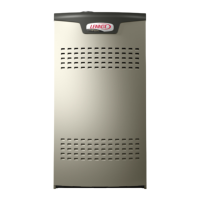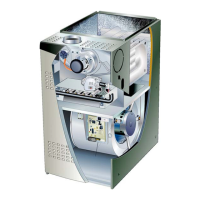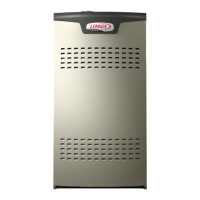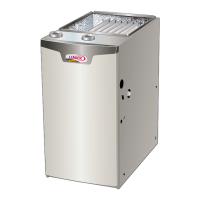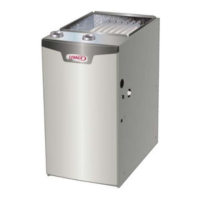Page 15
9 - If the common vertical vent is oset, the maximum
common vent capacity listed in the common venting
tables should be reduced by 20%, the equivalent
of two 90° elbows (0.80 x maximum common vent
capacity). The horizontal length of the oset shall not
exceed 1-1/2 feet (.46 m) for each inch (25 mm) of
common vent diameter.
10 - The vent pipe should be as short as possible with
the least number of elbows and angles required to
complete the job. Route the vent connector to the
vent using the shortest possible route.
11 - A vent connector shall be supported without any
dips or sags and shall slope a minimum of 1/4 inch
(6.4 mm) per linear foot (305 mm) of connector,
back toward the appliance.
12 - Vent connectors shall be rmly attached to the
furnace ue collar by self-drilling screws or other
approved means, except vent connectors of listed
type B vent material which shall be assembled
according to the manufacturer’s instructions. Joints
between sections of single wall connector piping
shall be fastened by screws or other approved
means.
13 - When the vent connector used for Category I
appliances must be located in or pass through
a crawlspace, attic or other areas which may
be cold, that portion of the vent connector shall
be constructed of listed double-wall type B vent
material or material having equivalent insulation
qualities.
14 - All venting pipe passing through oors, walls, and
ceilings must be installed with the listed clearance
to combustible materials and be re stopped
according to local codes. In absence of local codes,
refer to NFGC (Z223.1).
15 - No portion of the venting system can extend into,
or pass through any circulation air duct or plenum.
16 - Vent connectors serving Category I appliances shall
not be connected to any portion of mechanical draft
systems operating under positive pressure such as
Category III or IV venting systems.
17 - If vent connectors are combined prior to entering
the common vent, the maximum common vent
capacity listed in the common venting tables must
be reduced by 10%, the equivalent of one 90° elbow
(0.90 x maximum common vent capacity).
18 - The common vent diameter must always be at least
as large as the largest vent connector diameter.
19 - In no case, shall the vent connector be sized more
than two consecutive table size diameters over the
size of the draft hood outlet or ue collar outlet.
20 - Do not install a manual damper, barometric draft
regulator or ue restrictor between the furnace and
the chimney.
21 - When connecting this appliance to an existing
dedicated or common venting system, you must
inspect the venting system’s general condition
and look for signs of corrosion. The existing vent
pipe size must conform to these instructions and
the provided venting tables. If the existing venting
system does not meet these requirements, it must
be resized.

